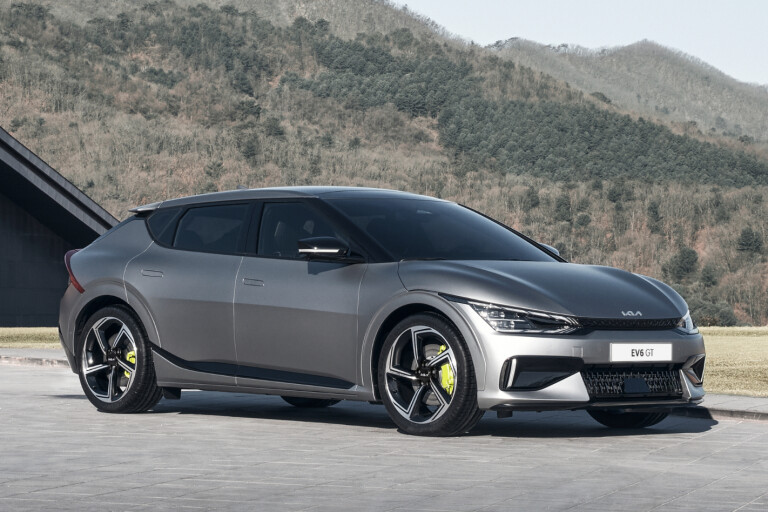
Snapshot
- Over 510 kilometres of range from a single charge
- 800V ultra-fast charging from 10 to 80 per cent in just 18 minutes
- 100 kilometres of range capable in less than 4.5 minutes of charging
- EV6 GT capable of accelerating from 0-100 km/h in 3.5 seconds
Kia has officially unveiled its first-ever battery-electric vehicle (BEV), the EV6, and it’s boasting some class-leading features that could upset the traditional players in the EV market.
Available from launch in three different models – EV6, EV6 GT-Line, and EV6 GT – the sleek-looking crossover is based on the Hyundai Motor Group’s E-GMP electric vehicle architecture, shared with Hyundai’s recently unveiled Ioniq 5.
Battery performance
The EV6 and EV6 GT-Line will be available with either a standard-range 58.0-kWh battery pack or a long-range 77.4-kWh battery pack, and can also be specified in either rear-wheel drive or all-wheel drive.
The 2WD 58.0-kWh battery pack will produce 125kW and 350Nm, while the AWD 58.0-kWh battery will churn out 173kW and 605Nm.
The 2WD variant of the longer-range 77.4-kWh battery pack is rated at 168kW and 350Nm, and the AWD version is capable of 239kW and 605Nm.

Models with the smaller battery bank and AWD will be capable of accelerating from 0-100km/h in 6.2 seconds, and models equipped with AWD using the larger battery pack will make the same sprint in 5.2 seconds.
Range will vary depending on the model, with the 2WD 77.4 kWh EV6 capable of travelling the farthest, rated at over 510 kilometres (316 miles) on a single charge on the WLTP combined cycle.
According to Kia, the EV6 will feature ‘the world’s fastest charging time’ of any electric vehicle on sale thanks to supporting both 400V and crucially 800V ‘ultra-fast’ charging.
Kia claims that all models, regardless of which battery is optioned, will be capable of charging from 10 to 80 per cent in just 18 minutes when using the 800V ultra-fast charger.
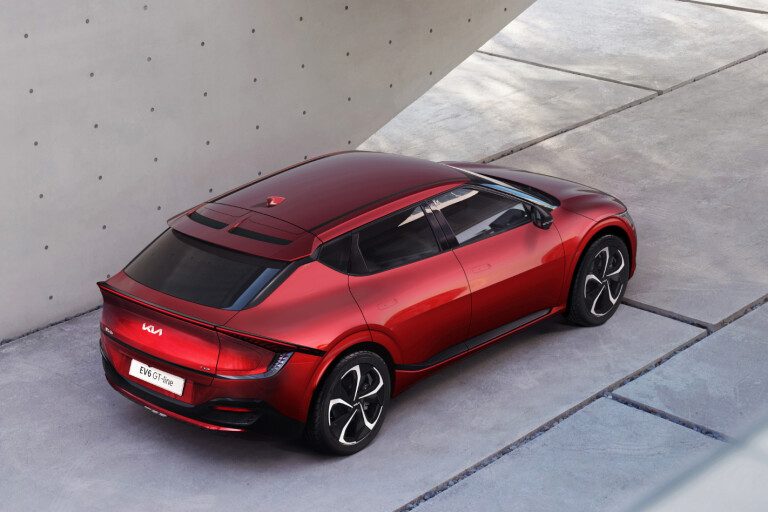
And, if the EV6 is specified with the 77.4 kWh battery pack and 2WD, owners will be able to add 100 kilometres of range to the EV in less than four and a half minutes, which Kia says is around the same amount of time it takes to refuel a conventional ICE-powered vehicle.
The charging system of the EV6 is also said to move the game on, utilising an Integrated Charging Control Unit (ICCU) that is capable of discharging the car batteries’ power to external devices through a vehicle-to-load (V2L) function.
This V2L function can supply up to 3.6 kW to devices such as a TV or air-conditioning unit, effectively acting as a generator.
As long as the battery pack has more than 35 per cent of charge, the EV6 is also capable of towing items weighing up to 1,600 kilograms, which should prove popular in the Australian market.
Kia will be offering a wall-mounted charging station similar to Tesla’s Wall Connector as an additional accessory to purchase with the EV6, and while there are no official plans for Kia/Hyundai to create local charging infrastructure, the automaker will continue to assess the issue into the future.
The Kia EV6 GT – The fastest Kia ever produced
The range-topping EV6 keeps the ‘GT’ badging we’ve seen on other high-performance Kia products like the Stinger GT, and the manufacturer promises the EV will more than live up to the performance pedigree that the designation already delivers.
With dual battery-powered motors driving the front and rear axle and a combined 430kW and 740Nm on tap, the EV6 GT will sprint from 0-100km/h in just 3.5 seconds and it won’t stop surging until it reaches a heady 260km/h top speed.

The EV6 GT will also score an electronically controlled limited-slip differential, which should also make for a dynamic driving experience when the going gets twisty.
These astounding performance figures and features mark the EV6 GT out as the fastest car Kia has ever produced, which is impressive considering its circa two tonne weight and family friendly crossover credentials.
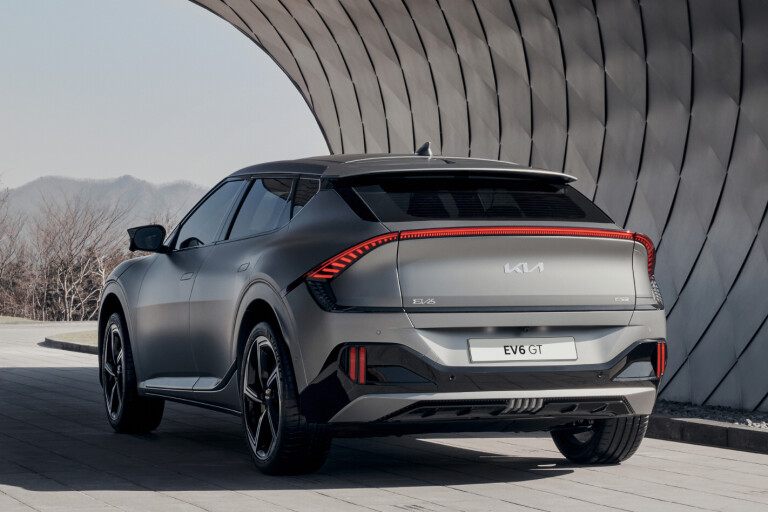
“The GT version of EV6 demonstrates our technological leadership through its combination of outstanding high-speed charging and acceleration performance like a super sports car,” said Albert Biermann, president and head of R&D division for Hyundai Motor Group.
“With our dedicated EV platform, there is no need for compromise between inspiring spaciousness and performance.”
Exterior
The EV6’s handsome exterior showcases Kia’s design language for its future EV models, evolving the quintessential tiger-nose into a new ‘Digital Tiger Face’ that incorporates svelte daytime running lights with a sequential dynamic light pattern and a low air intake that visually widens the front of the car.
The rear of the EV is treated to a striking, continuous array of red LED lights that span the rear of the vehicle’s concaved tailgate.
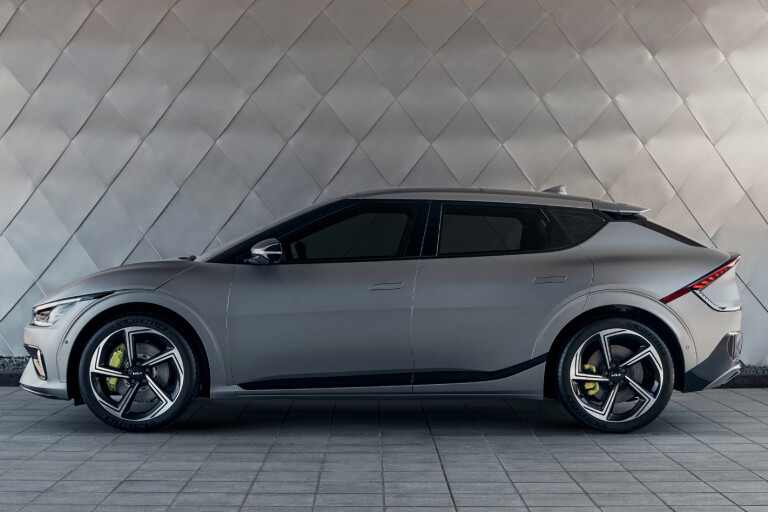
Below it sits a blacked-out rear diffuser with vertical red reflector strips and black cutouts that add an additional layer of visual complexity to the rear bumper’s fussy but ultimately good-looking rear end.
The car’s shooting-brake-like side profile accentuates its dynamic appearance, while short overhangs and both the front and rear of the car indicate another benefit of the E-GMP architecture – cabin space.
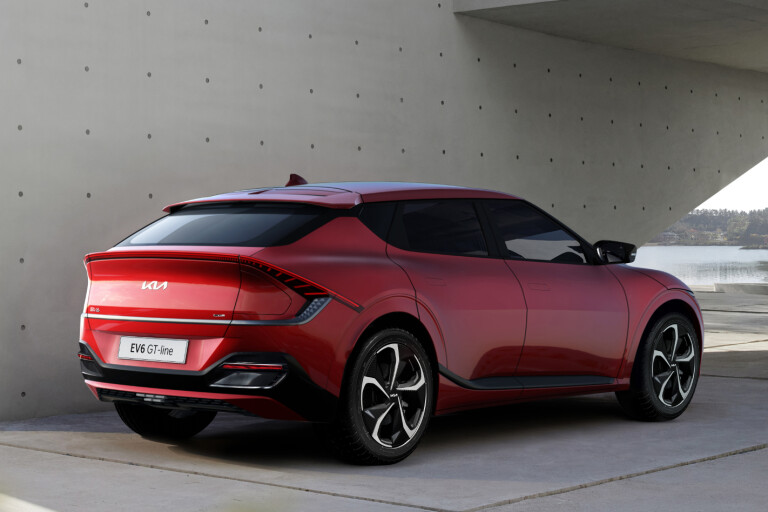
Kia claims that thanks to the EV6’s long wheelbase, which measures 2,900mm, and the flat-floor design that the EV’s architecture allows for, the result is an interior size similar to a medium to large size SUV.
As Jochen Paesen, vice president for interior design, explains: “People are first attracted by the exterior of cars, but they eventually fall in love with the interior – where they spend most of their time.
“So, designing an inspiring space for the EV6 was the most important thing for us. We believe EV6 can inspire customers by boosting their creativity.”
Interior
The interior of the EV6 is completely bespoke to the model and has several technical benefits that are new to Kia.
Dual 12-inch curved digital displays blend into one seamless strip across the car’s interior fascia, with one taking the place of a conventional dashboard and the other acting as a touchscreen interface for the infotainment system.
Kia’s ‘Kia Connect’ operating system, formerly known as UVO, comes as standard on the EV6 and allows owners to do things like finding locations for charging points, view the vehicle’s charging status, plan a smart charging schedule and check the vehicle’s range radius.
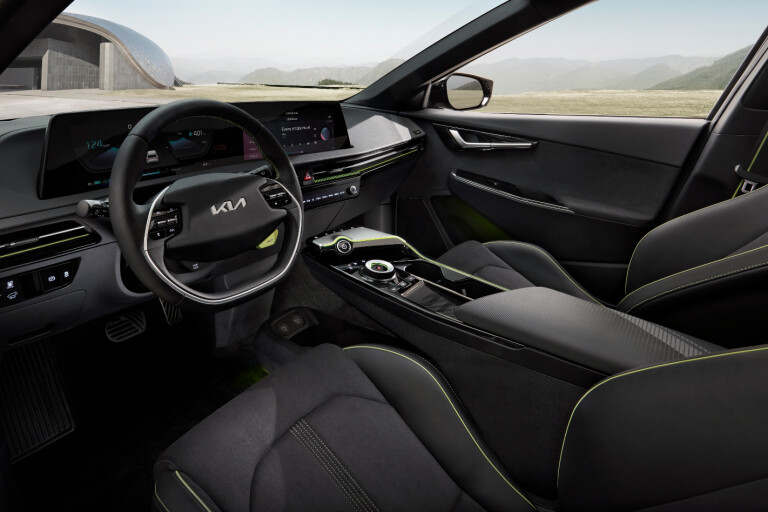
Other features such as Apple CarPlay, Android Auto, and wireless charging are also expected but have not been confirmed.
A 14-speaker Meridian surround audio system is also available, which Kia says will provide superlative audio quality.
The speaker system also gets Active Sound Design (ASD), which gives drivers audible feedback through the speakers, notifying them of the speed that the car is travelling, which can be managed through the user interface.
According to the automaker, the interior of the EV6 has been partially manufactured with recycled plastics equivalent to 111 plastic water bottles.
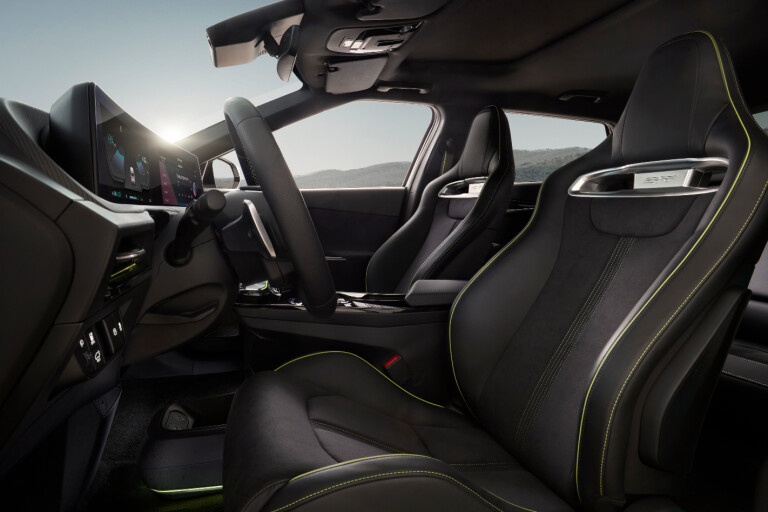
The EV6 also offers 520 litres (VDA) of boot space with second row seats in place and approximately 1,300 litres of storage with the second row seats folded down.
The car also scores a ‘frunk’ that provides up to 52 litres of storage space for 2WD models and 20 litres for AWD models.
Safety
An augmented reality head-up display system is also equipped, which displays driving information onto the windscreen’s base, ensuring it is legible for the driver.
The head-up unit can display notifications from the car’s Advanced Driver Assistance System, such as vehicle speed and navigational instructions.

Kia says the EV6 will come with ‘Level 2’ autonomous driving functions and safety features such as Safe-Exit Assist (SEA), Lane-Following Assist (LFA), Highway Driving Assist 2 (HDA2), and Remote Smart Parking Assist (RSPA).
Sales and availability
The EV6 is projected to be a crucial car for Kia and its future EV direction, with the carmaker expecting to sell 100,000 units of the vehicle in total.
Of that 100,000, 30,000 units are expected to be sold in Kia’s domestic market, 40,000 units will be sold in the European market, 20,000 units will be sold in the North American market and other regions will make up the remaining 10,000 units to be sold.
Kia Australia has confirmed to WhichCar that Australia will be receiving the EV crossover, and production is due to begin in Q4 of this year.
However, we do not know when the EV6 will arrive Down Under, nor do we know how much it will cost.
Be sure to watch this space and circle back to WhichCar for all the latest on Kia’s EV6.

COMMENTS